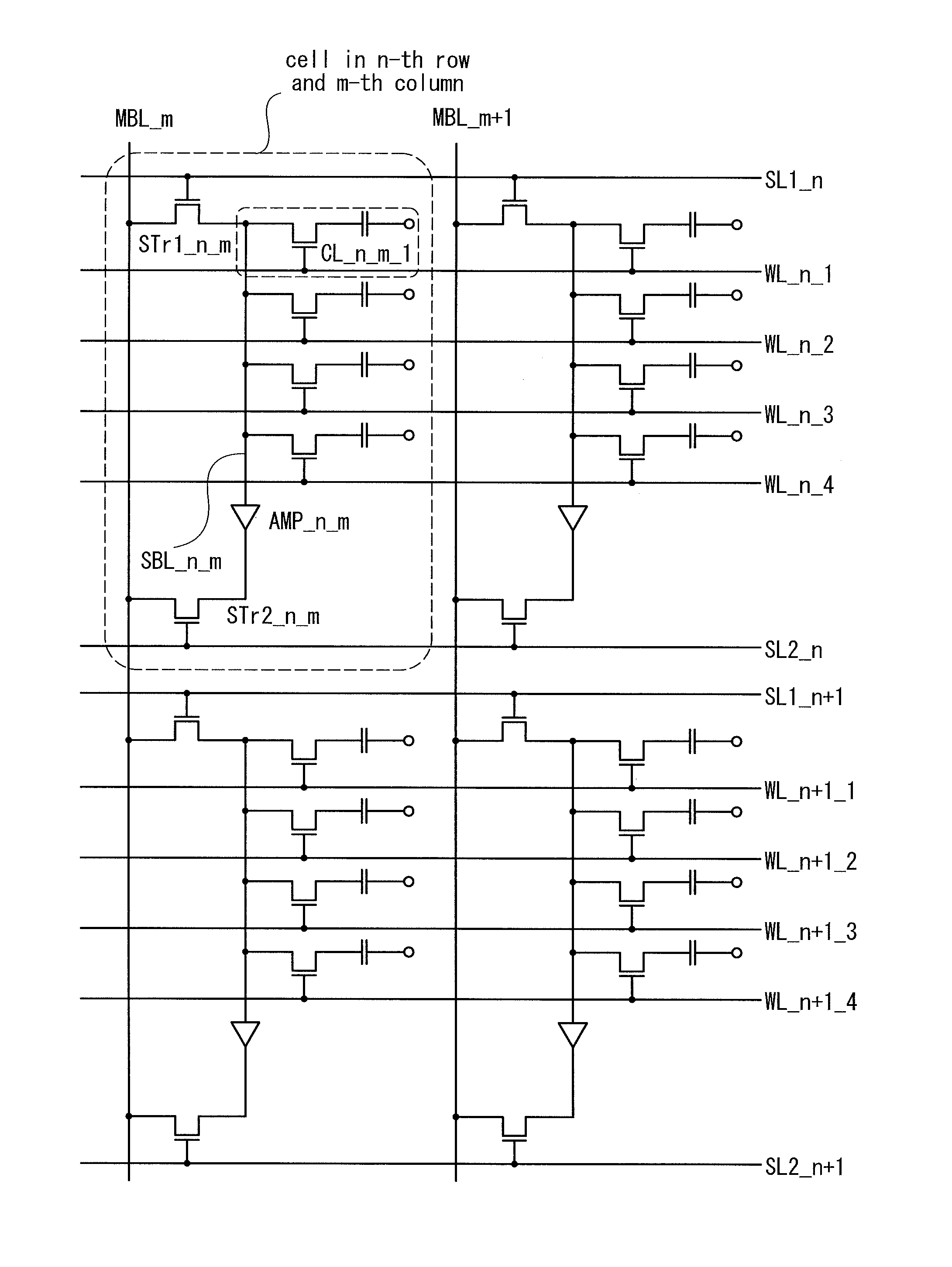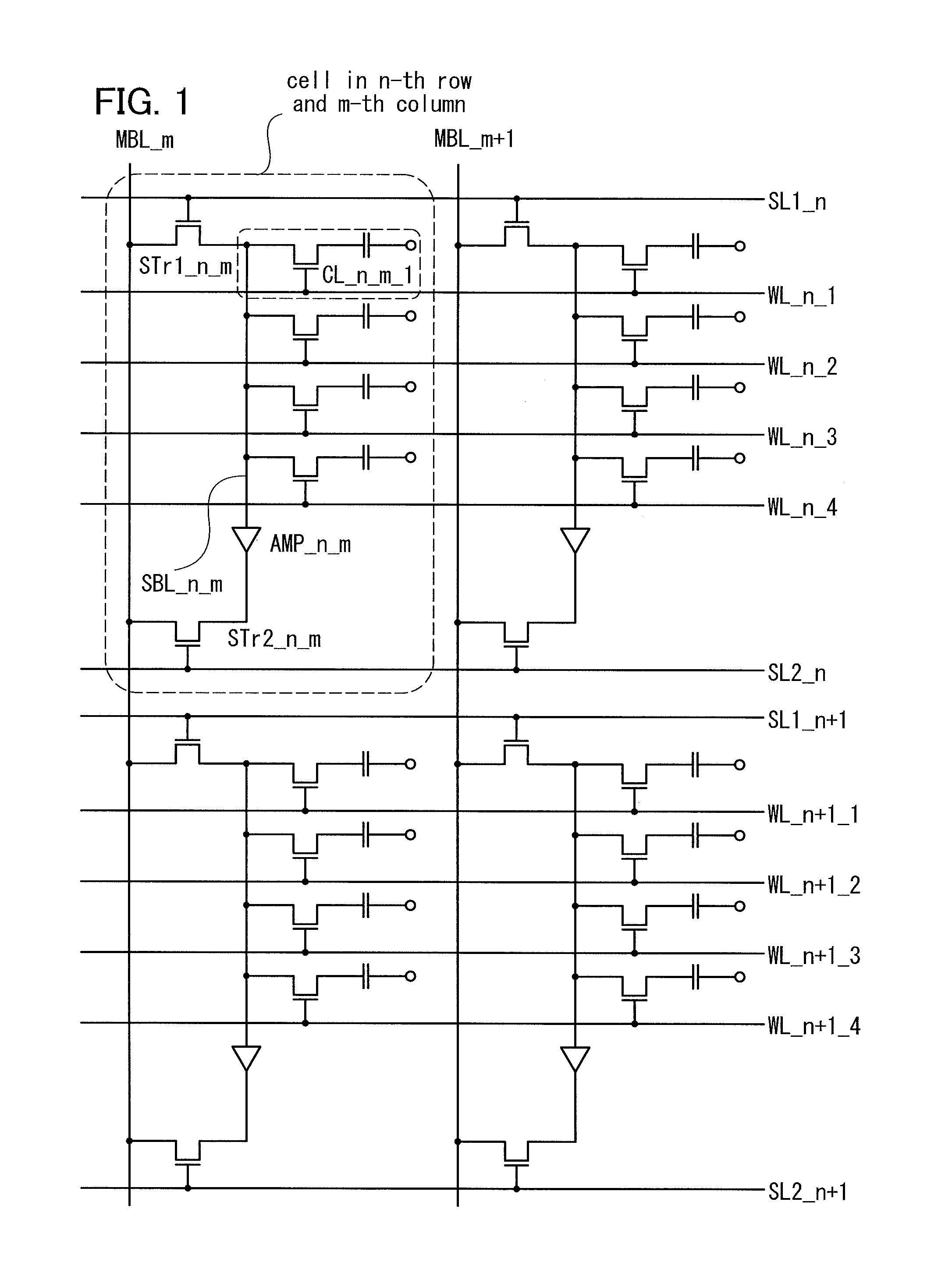Semiconductor memory device and method for driving the same
a memory device and semiconductor technology, applied in semiconductor devices, digital storage, instruments, etc., can solve the problems of less potential change, less reading accuracy, and more complex data reading when compared to data writing, and achieve the effect of sufficient capacitan
- Summary
- Abstract
- Description
- Claims
- Application Information
AI Technical Summary
Benefits of technology
Problems solved by technology
Method used
Image
Examples
embodiment 1
[0065]In this embodiment, a semiconductor memory device illustrated in FIG. 1 and an example of its operation are described with reference to FIGS. 2A to 2 C, FIGS. 3A and 3B, FIGS. 4A to 4C, and FIGS. 5A to 5C. Note that specific values are given below as potentials for the purpose of aid for understanding the technical idea of the present invention. Needless to say, such values are changed in accordance with various characteristics of a transistor, a capacitor, or the like, or for convenience of the practitioner. Further, the semiconductor memory device described in this embodiment can write or read data using a method other than a method described below.
[0066]The semiconductor memory device illustrated in FIG. 1 includes word lines WL, bit lines MBL intersecting with the word lines, first selection lines SL1 and second selection lines SL2 which are parallel to the word lines WL, and a plurality of cells. Each cell includes a first selection transistor STr1, a second selection tra...
embodiment 2
[0108]An example of a method for manufacturing a semiconductor memory device according to part of the technical idea of the present invention is described with reference to FIGS. 6A to 6C, FIGS. 7A and 7B, and FIG. 8. Note that FIGS. 6A to 6C, FIGS. 7A and 7B, and FIG. 8 show cross sections of the semiconductor memory device following a process for manufacturing the semiconductor memory device; the cross sections do not show the cross-sections of a specific part.
[0109]First, by a known semiconductor processing technique, an element separation insulator 102, a p-well 101P, and an n-well 101N are formed over one surface of a substrate 101 which is formed of a single crystal semiconductor such as silicon, gallium arsenide, gallium phosphide, silicon carbide, germanium, or germanium silicide. Further, a gate 104N of an n-channel transistor, an n-type impurity region 103N, a gate 104P of a p-channel transistor, and a p-type impurity region 103P are formed. In addition, a first interlayer...
embodiment 3
[0124]In this embodiment, a semiconductor memory device illustrated in FIG. 10 and an operation example thereof are described. FIG. 10 shows the cell in the n-th row and the m-th column, the cell in the n-th row and the (m+1)-th column, and part of a driver circuit in the m-th column and the (m+1)-th column which are included in the semiconductor memory device.
[0125]The cell of the semiconductor memory device of this embodiment includes the first selection transistor STr1, the second selection transistor STr2, a plurality of memory cells, an amplifier circuit, and the sub bit line SBL. Although the n-channel transistor NMOS is included as the amplifier circuit in the semiconductor memory device illustrated in FIG. 10, a p-channel transistor may be alternatively used.
[0126]The drain of the first selection transistor STr1_n_m and the drain of the first selection transistor STr1_n_m+1 are respectively connected to the bit line MBL_m and the bit line MBL_m+1; the source of the first sel...
PUM
 Login to View More
Login to View More Abstract
Description
Claims
Application Information
 Login to View More
Login to View More - R&D
- Intellectual Property
- Life Sciences
- Materials
- Tech Scout
- Unparalleled Data Quality
- Higher Quality Content
- 60% Fewer Hallucinations
Browse by: Latest US Patents, China's latest patents, Technical Efficacy Thesaurus, Application Domain, Technology Topic, Popular Technical Reports.
© 2025 PatSnap. All rights reserved.Legal|Privacy policy|Modern Slavery Act Transparency Statement|Sitemap|About US| Contact US: help@patsnap.com



